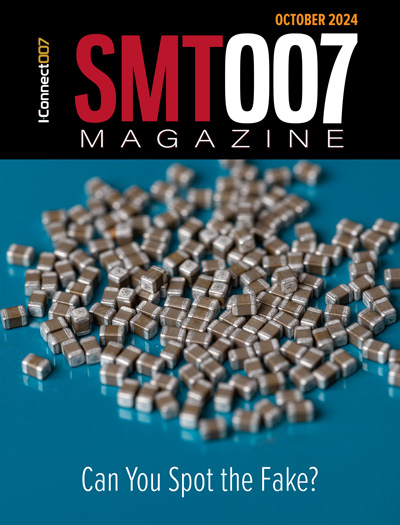-

- News
- Books
Featured Books
- smt007 Magazine
Latest Issues
Current Issue
The Rise of Data
Analytics is a given in this industry, but the threshold is changing. If you think you're too small to invest in analytics, you may need to reconsider. So how do you do analytics better? What are the new tools, and how do you get started?

Counterfeit Concerns
The distribution of counterfeit parts has become much more sophisticated in the past decade, and there's no reason to believe that trend is going to be stopping any time soon. What might crop up in the near future?

Solder Printing
In this issue, we turn a discerning eye to solder paste printing. As apertures shrink, and the requirement for multiple thicknesses of paste on the same board becomes more commonplace, consistently and accurately applying paste becomes ever more challenging.
- Articles
- Columns
Search Console
- Links
- Media kit
||| MENU - smt007 Magazine
Cellular IoT connectivity revenues reached € 12.4 billion in 2023
August 2, 2024 | Berg InsightEstimated reading time: 2 minutes
A new report from the IoT market research firm Berg Insight says that global IoT connectivity revenues increased 16 percent to reach € 12.4 billion in 2023. The advancement of the industry drives a shift towards greater focus on reliability, security and support for international deployments, contributing to new types of market dynamics for cellular IoT connectivity providers. By 2028, Berg Insight projects that there will be 6.0 billion IoT devices connected to cellular networks worldwide, generating annual connectivity revenues of € 21.0 billion.
The top ten mobile operators reported a combined active base of 2.9 billion cellular IoT connections at the end of 2023, accounting for 88 percent of the total 3.3 billion connections. China Mobile is the world’s largest provider of cellular IoT connectivity services with 1.32 billion cellular IoT connections. China Telecom and China Unicom ranked second and third with 527 million and 494 million connections respectively. Vodafone ranked first among the Western operators and fourth overall with 184 million connections, followed by AT&T with 128 million in fifth place. Deutsche Telekom and Verizon had in the range of 50–57 million cellular IoT connections each. Telefónica, KDDI and Orange were the last players in the top ten with about 41 million, 40 million and 37 million connections respectively. The growth in the installed bases of the largest mobile operators varied, with changes ranging from a 1 percent decrease to a 31 percent increase year-on-year.
IoT managed service providers play a key role in the ecosystem. Most players operate as full MVNOs, typically offering IoT connectivity services based on a mix of roaming and local access agreements and sometimes also value-added services targeted at vertical segments. Notable examples include 1GLOBAL, 1NCE, Aeris, BICS, Cubic Telecom, emnify, Eseye, floLIVE, KORE, Soracom, Tata Communications, Telit Cinterion, Velos IoT and Wireless Logic. Altogether, IoT managed service providers had more than 200 million cellular IoT connections under management at the end of 2023 and around € 1.7 billion in annual revenues.
International connectivity constitutes one of the largest and fastest growing segments of the cellular IoT market. Mobile operators with regional and multi-regional operations are naturally positioned to offer IoT connectivity services for international deployments at competitive rates, leveraging their network footprints and ability to negotiate favourable roaming agreements. The priorities of many mobile operators and their IoT businesses however grow to become increasingly misaligned, as the telecom industry trends towards increased consolidation of operations to key markets and integration of fixed and mobile network operations. This has led to a greater separation between mobile operators’ IoT businesses and network operations, resulting in more open approaches to global network access in line with the strategies of IoT managed service providers. Established IoT managed service providers however typically have more advanced localisation capabilities through IMSI and eSIM profile donor agreements. Going forward, Berg Insight believes that the separation of IoT connectivity businesses and networks will continue, driven by changing industry dynamics and a shift to new eSIM technologies. This implies a strong case for global consolidation of cellular IoT connectivity platforms.
Suggested Items
Würth Elektronik Offers its Radio Module for LoRaWAN Communication
11/19/2024 | Wurth ElektronikWürth Elektronik launches Daphnis-I on the market – a slim, ultra-low power consumption and long range radio module for IoT applications.
Zero Defects International to Exhibit at Silicon Valley Expo and Tech Forum
11/19/2024 | Zero Defects InternationalZero Defects International [ZDI] has announced their participation as an exhibitor at the Silicon Valley Expo and Tech Forum. It will be held at the Fremont Marriott Silicon Valley.
Learn How to Reduce Unplanned Downtime with Innovative Smart Factory Solutions
10/16/2024 | PRNewswireFlowfinity, a leading no-code business application development and smart factory solutions platform, empowers manufacturers to reduce costly unplanned downtime and material waste through custom IoT deployments.
Global Satellite IoT Subscriber Base to Reach 26.7 Million by 2028
10/14/2024 | Berg InsightThe global satellite IoT communications market is growing at a good steady pace according to a new research report from specialist IoT analyst firm Berg Insight.
Iridium to Collaborate with Nordic Semiconductor on Iridium NTN Direct integration
10/11/2024 | PRNewswireIridium Communications Inc., a leading provider of global voice and data satellite communications, announced its collaboration with Nordic Semiconductor for early integration of its Iridium NTN Direct℠ service into Nordic's LTE-M/NB-IoT modules and chipsets.


